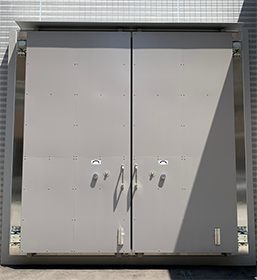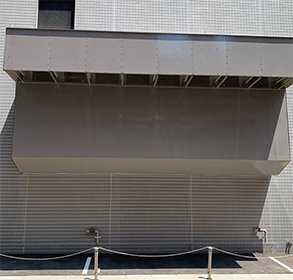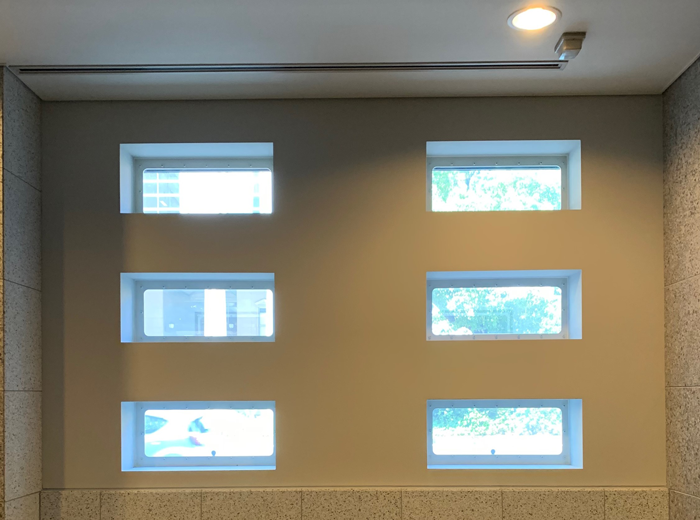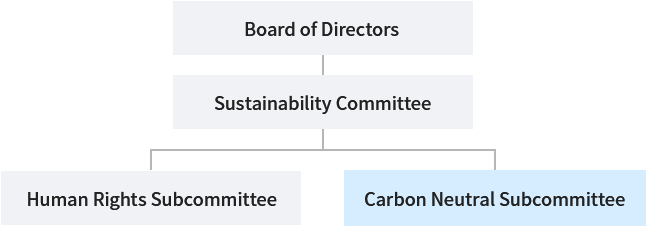- KDDI HOME
 Corporate Information
Corporate Information  Sustainability
Sustainability Environment
Environment Responses to the TCFD Recommendations
Responses to the TCFD Recommendations
Responses to the TCFD Recommendations
Responses to the TCFD Recommendations

KDDI announced our support for the Task Force on Climate-related Financial Disclosure (TCFD) in April 2021. We will strive to proactively disclose information based on the disclosure framework of governance, strategy, risk management and metrics and targets in accordance with the TCFD recommendations. We will also take concrete measures to address climate change and put them into actions.
(1) Governance
KDDI has the Sustainability Committee, chaired by the President and consisting of key members of the Board of Directors etc., to deliberate on issues related to sustainability such as the resolution of social issues through businesses (SDGs), social contributions, and measures against climate change. The Committee is responsible for following up on and discussing important issues and initiatives related to climate change at KDDI, monitoring risks and opportunities, and approving reports and other matters.
- Monitoring process related to climate issues
-
Sustainability Committee chaired by the President monitors the progress of the targets to contribute to realize decarbonized society. Specifically, the Carbon Neutral Subcommittee, under the supervision of Sustainability Committee, will monitor semi-annually the risk factors for not meeting the annual target and the opportunity factors in case the annual target is achieved. The results of the Carbon Neutral Subcommittee's monitoring are reported to the Sustainability Committee as climate-related risks and opportunities, and an assessment of materiality is made. The results of the monitoring and assessment of targets and measures related to climate-related issues will also be reported. The Sustainability Committee held semi-annually. In the first half of the year, the committee will "confirm the achievement of the previous year's targets" and "analyze factors and confirm countermeasures if targets were not achieved"; in the second half, the committee will "confirm the progress of the current year's targets" and "set targets for the next year". In addition, the Board of Directors receives quarterly reports from the Sustainability Committee on Climate Change and oversees and directs the implementation of measures to address important issues and initiatives.
(2) Strategy
KDDI carried out two types of analyses: (1) the 1.5°C scenario in which a decarbonized society will be rapidly realized (limiting the increase in global average temperature to 1.5°C above pre-industrial levels) in response to the Paris Agreement adopted at COP21, and (2) the 4°C scenario in which physical impact will become apparent due to lack of measures against climate change (the increase in the global average temperature is held at 4°C above pre-industrial levels).
On May 9, 2024, KDDI drew up the "KDDI GREEN PLAN," a medium- to long-term environmental conservation plan to contribute to the preservation of natural capital. KDDI has been working to enhance its environmental value under the "KDDI GREEN PLAN 2030," which focuses on "realizing a decarbonized society," "creating a circular economy," and "preserving biodiversity. This time, in order to enhance corporate value over the medium to long term, we have established new targets for risk reduction and the creation of business opportunities, and renamed the plan the "KDDI GREEN PLAN" to promote more vigorous activities aimed at further enhancing environmental value.
Scenario Analysis Results
| Analysis of Transition Risks | KDDI's Risks | KDDI's Responses | |
|---|---|---|---|
| Policy and Legal | Carbon Tax | Carbon taxation risk [1] |
Promoting activities to achieve carbon neutrality (Scope 1+2 CO2 emissions) for the entire KDDI Group by the end of FY2030. |
| Tokyo Metropolitan Ordinance/ Emission Regulations |
Risk of increased costs of buying credits (allowances) for unachieved CO2 emission reductions | Emission credits equivalent to 190,000 t-CO2 of unachieved CO2 emissions expected to occur during the Third Plan period of FY2020-FY2024 (CO2 emission credits generated during the Second Plan period) were purchased in advance for 40,000 t-CO2 in FY2020 and 150,000 t-CO2 in January 2023. These emission credits are scheduled to be allocated in FY2025-FY2026 depending on the results of the third planning period from FY2020 to FY2024. | |
| Introduction of New Technologies to Reduce Power Consumption and CO2 Emissions (mid-term strategy) | Risk of increased power consumption of telecommunication facilities arising from increased communication volume | Aiming to create a sustainable data center that contributes to decarbonization, we are currently conducting joint research and development with Mitsubishi Heavy Industries, Ltd. and NEC Nets-SI to reduce power consumed for server cooling by 94% using immersion cooling equipment that cools IT equipment with liquid. Also promoting reduction of power consumption by introducing base station sleep function (sleep during nighttime when traffic is low). Developing functions for one model of millimeter wave radios in-house, accumulating know-how, and identifying issues. It is expected to reduce power consumption by approximately 100 kWh per year per radio. | |
| Market and Reputation (long-term strategy) | Risk of KDDI's corporate reputation declining and subscriber decline due to failure to meet carbon neutrality targets and delays in renewable energy initiatives | Promoting the switch from fossil fuel-derived electricity to renewable energy electricity. Plans to switch 2.7 billion kWh of electricity consumed in our business operations to a renewable energy-derived menu. Also, established au Renewable Energy as a group company and started renewable energy power generation business with additional potential such as solar power generation. | |
- [1]Since the estimated CO2 emissions in FY2030 are approximately 675,000 t-CO2, an annual tax of approximately 12.38 billion yen is assumed for a carbon tax of 18,340 yen/t-CO2 based on the IEA NZE 2050. The cost required to switch to renewable energy to reduce taxable CO2 emissions is assumed to be about 5.4 billion yen.
| Analysis of Physical Risks | KDDI's Risks | KDDI's Responses | |
|---|---|---|---|
| Acute Risk | Increase in severity and frequency of disasters caused by extreme weather (typhoons, floods, etc.) | Risk of increased costs such as personnel expenses for emergency recovery in order to respond quickly to the restoration of the communication network | Preparation for efficient recovery operations by reviewing the BCP [3] and conducting disaster recovery drills |
| Chronic Risk | Increase in average temperature | Risk of increased air-conditioning power usage in data centers to cool servers entrusted to us by our customers [2] | Installation of highefficiency air conditioning systems and replacement with renewable energy power |
- [2]Of the 3,000 operation and maintenance personnel, the remaining 2,000 operation and maintenance personnel are to cover the normal workload of 1,000 dedicated to emergency recovery, which is estimated to be 4 hours of overtime per day for 10 days, based on past examples of disaster recovery at each site. The cost of reviewing the BCP from a medium-term perspective (~2030) and conducting training based on the BCP is assumed to be approximately 96 million yen.
- [3]Business Continuity Plan
- Water risk assessment and our response
-
Climate change in recent years has increased concerns about business risks, including water damage. KDDI conducts water risk assessments and implements countermeasures as a preliminary measure to prepare for efficient recovery activities in the event of a disaster.
KDDI systematically carries out countermeasure works at sites that are highly susceptible to flooding based on the estimated height of inundation in the "expected flood inundation zone (estimated maximum: once in 1,000 years)" as determined by the Ministry of Land, Infrastructure, Transport and Tourism or the prefectural government.
- [Examples]
-
- Example 1
- Site
-
Site A in Chugoku area in Japan
- Measurement
-
Installation of water proof door, covered glass window by concrete wall (water barrier wall), raised ducts for generator supply and exhaust ports
installation of backflow prevention valves in toilets, etc.
- Construction period
-
June 2022
- Example 2
- Site
-
Site B in Kyushu are in Japan
- Measurement
-
Installation of water proof door and water barrier shutter, convered opening such as window by concrete, waterproofing measures for generator supply and exhaust ports, etc.
- Construction period
-
By the end of FY2024
- [Main measurements]
-

Water proof door 
Raised ducts for generator supply and exhaust ports 
Water barrier wall
| Analysis of Opportunities | KDDI's Opportunities | KDDI's Resoponses |
|---|---|---|
| Introduction of New Technologies to Reduce Power Consumption and CO2 Emissions (mid-term strategy) | Increased sales due to increased demand for services using renewable energy [4] |
In response to the need to use renewable energy for data center services that store customers' servers, etc., KDDI is promoting the switch to renewable energy at our data centers. |
| Increase in sales by providing environmentally friendly electric power services | Offers a renewable energy menu linked to power supply costs for corporate customers, and electricity service with virtually 100% renewable energy ratio for individual customers. |
- [4]Estimated increase in sales of approximately 63.2 billion yen due to increased demand for data center services in Germany, France, and the United Kingdom. In addition, costs for procurement of renewable energy are assumed to be approximately 11 billion yen.
(3) Risk Management
The KDDI Group recognizes that risks and opportunities in dealing with climate-related issues on its business operations are an important part of its business strategy, and manages them through a company-wide risk management process. Specifically, the KDDI Group evaluates climate change risks and opportunities that could have a significant financial and strategic impact on the KDDI Group from all business activities, including those upstream and downstream in the KDDI Group's supply chain, from the perspective of what management and the Sustainability Management Division consider to be important issues and what each business division considers to be important issues.
The Corporate Sustainability Management Division, which is responsible for KDDI Group risk management, assesses climate change risks and opportunities that could have a significant impact on the KDDI Group's finances and business strategies, and the management and Sustainability Management Division assesses the risks and opportunities for all business units. The Division identifies risks for all business units twice a year on a semiannual basis. Among the identified risks, risks related to climate change are managed through an environmental management system (EMS) approach, utilizing the Environmental ISO framework. For each risk to be managed, quantitative annual targets for risk reduction are established in each relevant lead department, and progress is evaluated on a quarterly basis. Improvements identified in the progress evaluation are reported to the Carbon Neutral Subcommittee, under the control of Sustainability Committee, and risks and opportunities related to the entire company and all divisions are discussed and approved by the Sustainability Committee.

(4) Metrics and Targets
In order to accelerate the realization of a decarbonized society, KDDI has established four environmental targets, including a goal for the KDDI Group [5] to achieve net zero emissions by the end of FY2040.
| Environmental Targets [6] | Target year (Fiscal year) |
Content | |
|---|---|---|---|
| 1 | KDDI Group to achieve net-zero | 2040 | Aiming to achieve "net zero" CO2 emissions from KDDI's business activities (Scopes 1 [7] and 2 [8]) and from KDDI's entire supply chains including Scope 3 [9]. |
| 2 | KDDI Group to achieve carbon neutrality | 2030 | KDDI Group to bring the year of achieving carbon neutrality carrying it forward by 20 years. (Scope 1 and 2) |
| 3 | KDDI to turn to renewable energy with additionality [10] by more than 50% | 2030 | KDDI to aim for sourcing over 50% of the electricity it consumes from renewable sources with additionality. |
| 4 | Telehouse datacenters to switch 100% of the electricity it uses to electricity from renewable sources | 2025 | The electricity used by the datacenters ran by the KDDI Group under the Telehouse brand will be switched to 100% from renewable sources. KDDI bring the year of achieving this target carrying it forward by one year from the previous target. |
- [5]Targeting KDDI and KDDI's consolidated subsidiaries
- [6]To see the definitions of the targets, visit our Website.
- [7]Direct greenhouse gas emissions by the business itself
- [8]Indirect emissions from the use of electricity, heat, and steam supplied by others
- [9]Indirect emissions other than Scope 2 (emissions by others related to the activities of the business)
- [10]The introduction of new photovoltaic power generation equipment by the company itself should have the effect of increasing the amount of renewable energy introduced into society as a whole.
KDDI has been calculating KDDI's non-consolidated greenhouse gas emissions since FY2012 and the KDDI Group's greenhouse gas emissions since FY2021 to quantitatively understand our environmental impact and manage the risks and opportunities that climate change poses to our company.
| CO2 emissions | FY2022 (result, group) |
|---|---|
| Scope 1 (Direct greenhouse gas emissions by the business itself) | 91,683t-CO2 |
| Scope 2 (Total of Indirect emissions from the use of electricity, heat, and steam supplied by others) | 1,319,693t-CO2 |
For the latest information, please refer to the description of greenhouse gas Scope 1+2 emissions (actual results) in the Sustainability Integrated Report 2024 to be released in September or later. KDDI has set a goal of reducing its Scope 3 emissions, which are indirect emissions other than Scope 2, by the end of FY2040, and the actual amount of Scope 3 emissions in FY2022 was 5,252,273 t-CO2 on a non-consolidated basis. Category 1 and Category 2 emissions accounted for 92% of the total Scope 3 emissions, and KDDI will continue to promote activities to reduce GHG emissions.
In addition, in order to understand the status of the KDDI Group's supply chain as a whole, we conduct surveys of our major suppliers to raise awareness and support their understanding of the importance of environmental initiatives in sustainable procurement, and ask them to share the status of issues and initiatives. The results of the survey and other matters related to the promotion of sustainable procurement are regularly reported to and supervised by the director in charge of sustainability (General Manager of Corporate Division). In fiscal 2023, the three companies (Nippon Telegraph and Telephone Corporation, KDDI Corporation, and SoftBank Corporation) introduced a common SAQ (Self-Assessment Questionnaire) to further strengthen engagement with suppliers.
- Recommended Contents
-


